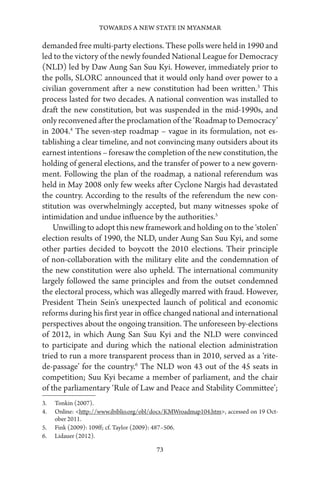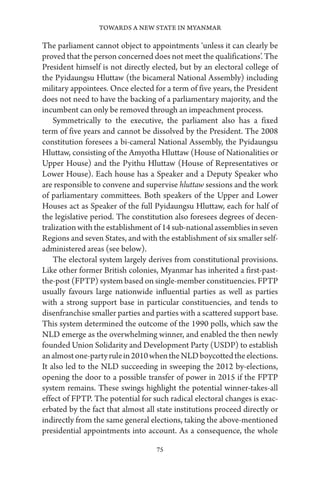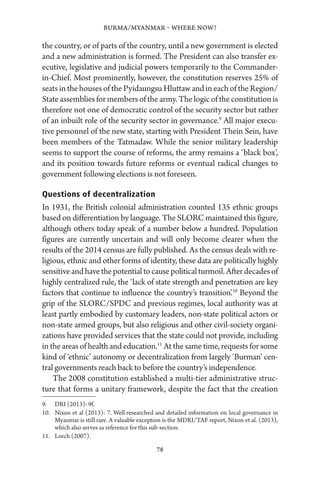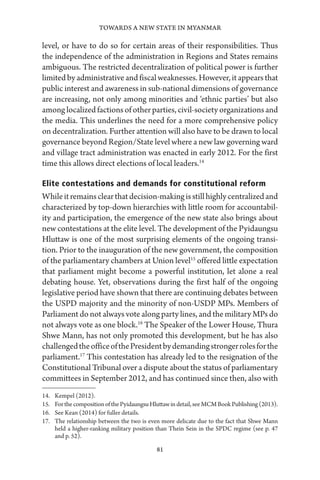The document discusses the evolution of the political state in Myanmar, notably following the implementation of the 2008 constitution, which has faced criticism for its military influence and lack of democratic standards. It outlines the complexities of the governance system established by this constitution, including the hybrid executive structure, limitations on decentralization, and challenges faced by political parties, particularly the National League for Democracy. The ongoing debate surrounding the constitution and the military's role in governance continues to shape Myanmar's political landscape ahead of the 2015 general elections.





![Towards a new state in Myanmar
77
The military remains an important political and economic actor, both
based on its self-conception as protector of the country’s unity since
independence and the position of power gained and maintained over
the last five decades. The 2008 constitution states in its basic principles
that the ‘Defence Services [are] to be able to participate in the National
[sic] political leadership role of the State’ and gives substantial power
to the Tatmadaw in the governance of the country. This role is realised
among others through a close consultative relationship between the
President and the Commander-in-Chief in the appointment procedures
ofgovernmentalofficials,andthroughstrongmilitarypowersinastateof
emergency.Themilitarycaninterveneincaseofdangerforlifeandprop-
erty of people in particular parts of the country, and the Commander-in-
Chief ‘has the right to take over and exercise state sovereign power […]
if there arises a state of emergency that could cause disintegration of the
Union, disintegration of national solidarity and loss of sovereign power
or attempts therefore by wrongful forcible means such as insurgency
or violence.’ In states of emergency, the National Defence and Security
Council8
can suspend the constitution and take over the governance of
8. The National Defence and Security Council consists of the President, the two Vice-
Presidents, the Speaker of the Pyithu Hluttaw, the Speaker of the Amyotha Hluttaw, the
Commander-in-Chief of the Defence Services, the Deputy Commander-in-Chief of the
Defence Services, the Minister for Defence, the Minister for Foreign Affairs, the Minister
for Home Affairs, and the Minister for Border Affairs.
Separation of powers in Myanmar – judiciary (based on 2008 constitution)](https://image.slidesharecdn.com/towardsanewstateinmyanmar-171210044925/85/Towards-a-new-state-in-Myanmar-6-320.jpg)

![Towards a new state in Myanmar
79
of decentralized legislature could suggest dimensions of federalism. At
the sub-national level, the territory comprises 14 administrative units
(seven Regions and seven States), each with a Region/State assembly.
The rationale behind this division is based on the assumption that
Regions are predominantly inhabited by ethnic Burmans and States
predominantly by the name-giving national minorities (Chin, Kachin,
Kayah, Shan, Kayin, Mon, Rakhine and Shan). Otherwise, there is no
institutional difference between Regions and States. In addition to
the States, the 2008 constitution allows for self-administered areas for
‘National races with [a] suitable population’.12
The constitution makes one step towards decentralization in creat-
ing the directly elected Region and State assemblies, yet the executive
power at sub-national level remains in the hands of the central govern-
ment. This is illustrated in particular by the nomination of Region/State
Chief Ministers by the President, and by the reliance of the Regions and
States on officers of the General Administration Department (GAD),
a department of the military-led Ministry of Home Affairs, for their
administration. The Chief Ministers participate in the Region/State
hluttaws to which they are elected or appointed but they are accountable
only to the President, not to their assemblies. Military influence is also
given through the structure of the Ministry of Border Affairs. However,
the actual impact on decentralized governance of military representa-
tives in Region/State legislatures and executives is currently unclear.
The potential new political space in Regions/States has to date only
been explored in limited ways. Schedule Two of the 2008 constitution
lists eight sectors of governance over which the decentralized govern-
ment has legislative powers,13
but the specified responsibilities are
narrow and exclude such major areas as health and education. Many
significant departments and ministries remain centralized, although re-
forms are ongoing in Naypyidaw to give more autonomy to Regions and
States. Some Region/State governmental departments have to report to
their local government and some have to report to government at Union
12. The self-administered areas comprise five self-administered zones (Naga, Danu, Pa-O, Pa
Laung and Kokang) with 2–3 townships each, and one self-administered division (Wa)
with six townships. All self-administered areas are governed by a Leading Council with a
Chair; the Tatamadaw is integrated into these councils.
13. Finance and Planning; Economy; Agriculture and Livestock Breeding; Energy, Electricity,
Mining and Forestry; Industry; Transport, Communication and Construction; Social
Sector; and Management.](https://image.slidesharecdn.com/towardsanewstateinmyanmar-171210044925/85/Towards-a-new-state-in-Myanmar-8-320.jpg)





